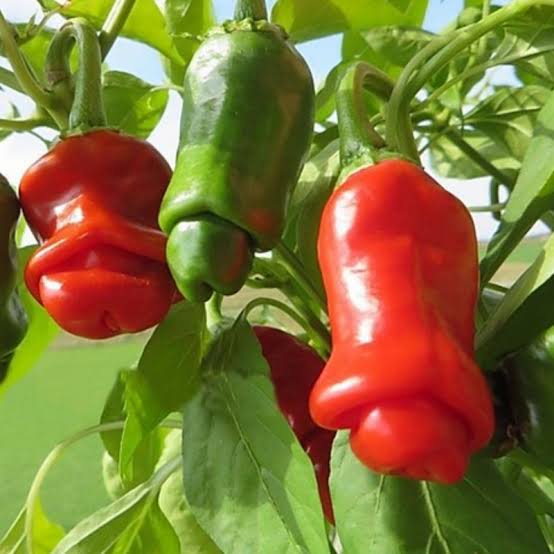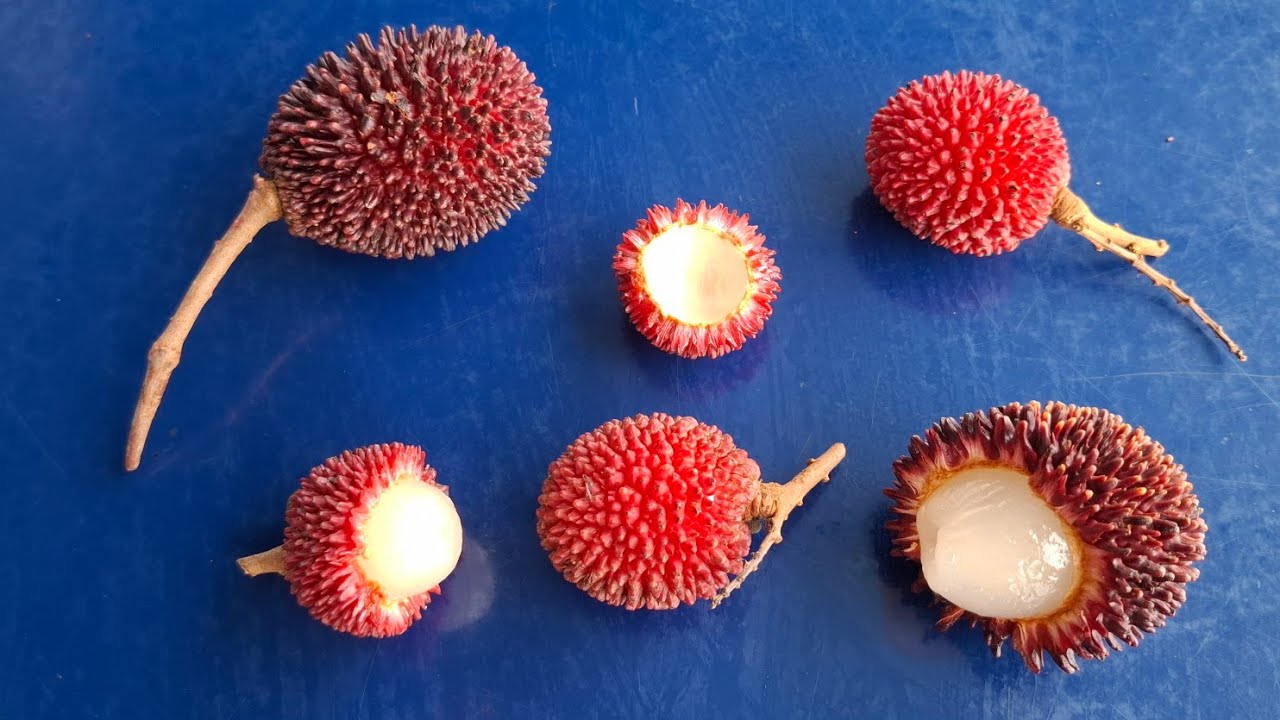Peach derives, through French, Old French, and vulgar Latin, from classical Latin, mālum Persicum meaning Persian apple.
Pear derives from Latin pirum meaning pear, likely taken from an unknown language, perhaps in the Semitic family, shares the same origin as the Greek word of the same meaning, apios.
Plum derives, through Old English, Old West Germanic, and Latin, from Greek proumnon which probably comes from an Anatolian language and means plum. Prune has the same origin, but came to modern English from Old French instead of Old English.
Pomegranate derives, through Old French, from Latin pomum granatum meaning many-seeded apple, pomus being the Latin word for fruit generally an later, for apples specifically. Interestingly, the English word for apple, while not quite beginning with ‘P’ almost gets there. But it’s always started with a vowel sound, being æppel in Old English, apalaz in Proto-Germanic from which apfel, appel, and epel of modern Germanic languages also derive. Even the reconstruced PIE word, abl, has basically the same sounds (devoiced “B” becoming a ‘P’ in Germanic languages) and overall form, making it a really well preserved word in English, similarly with the derivations in Irish, ubull, Slavic languages, jabloko (which is probably the closest to the original since the “ko” ending is just a diminutive suffix), and Baltic languages, obuolys in Lithuanian, wubla in Old Prussian.
Pumelo similarly derives from pomum.
Pumpkin derives, through French and Latin, from the Greek word pepon meaning gourd or melon. Funny enough, melon has a related root in Greek, mēlopepon meaning something like gourd-apple, mēlon being the Greek word for apple, hence malic acid.
Pepino also comes from pepon, as does pepita.
Pea comes, via Old English and Latin, from the Greek word pison, meaning pea.
Peanut comes from the same root pison, plus nut, a Germanic word, hnutu in Old English, sharing the same proto-Germanic root as the Old Norse hnot , Dutch noot , Old High German hnuz , and modern German Nuss.
Papaya comes, through Spanish, from a West Indies language and refers to the same fruit.
Pawpaw is a derivation of papaya.
Pecan comes, through French, from an Algonquian word pecane for nut. Related words include the Cree pakan, Ojibwa bagaan, and Abenaki pagann.
Persimon similarly comes from Algonquian, from the word pasimenan meaning hand-dried or artificially-dried.
Passionfruit comes from the Latin passivus, which meant to suffer or able to suffer. The root is the same for passive. It replaced the much cooler word þolung in English (Þ/þ is the letter for the unvoiced ‘th’ sound btw, a letter English unfortunately lost due to the printing press along with Ð/ð), though the Scots language, or dialect, retained it giving the modern Scots word thole meaning to endure. In modern English, a thole is the fulcrum pin for an oar or on a rowboat, a very rare word that shares a similar meaning to the Scots word since it’s a small bit of wood that has to endure the full force of the oar or paddle. So in the hypothetical language of Anglish, passionfruit would be something like þolunæppel, the fruit of suffering.
Pindo palm comes from Guaraní, pindo, meaning palm, making pindo palm a tautology much like ahi tuna, added bonus, and etc, chai tea, etc. Now it is is natively called the coquinho-azedo or butia in most of Brazil.
Pineapple, or more specifically the word pine, comes from Latin, through French, pinus, meaning pine. Basically every other language on Earth calls that fruit an ananas.
Pineapple guava, ditto.
Pinion is a funny one because there is a word “pinion” in English that refers to a wing joint or more recently wing feathers, and is derived from Latin pinna meaning wing. But pinion as in the nut is derived from Spanish piñón as it derives from the Latin root pinus, meaning it’s the same root as the English word pine, and it also means that pinion pine is also a tautology that just means pine pine.
Plantain is pretty cool. It refers both to the low-growing weed and to the starchy banana fruit. Plantain the weed comes from Anglo-French whereas plantain the fruit comes from Spanish. However, both of those words eventually trace back to the same Latin root, planta, but to different meanings of that word. Plantain the weed derives from planta meaning the sole of the foot, whereas plantain the fruit derives from planta meaning plant via a complex phenomenon where the word for plane, platanus, morphed into plantanus, gaining the ‘n’ from planta, meaning basically plane-plant and referring, quite appropriately plane-tree (or in American English, sycamore, which in the rest of the word refers to a kind of fig or a maple). Basically, plantains and plantains both refer to flat plants, but one came through Anglo-French and the other one came through Spanish.
Pistachio actually entered English twice. First, it came into Middle English as pystace via Old French and Vulgar Latin. Later, it reentered English as pistachio, which replaced the older version and is derived from Italian. Both version trace back to Latin, which got it from Greek, which got it from Old Persian, pistah.
Partridgeberry unsurprisingly comes from partridge, a bird, and berry. Partridge is a long derivation that ultimately comes from Greek perdix, also referring to the same bird, likely related to the verb perdesthai which means fart–the relation between the words coming from the sound of the bird’s wings in the wind. Berry is derived a really old Germanic word and related to the Swedish bär, German beere, Dutch bes, Afrikaans beesie, and Icelandic ber, all meaning berry.
Pepper comes from Greek piperi, probably itself derived, through Persian, from Sanskrit pippali. Almost all these words referred originally, and often to this day, to the black pepper plant or its near relatives. Most languages tend to use related but slightly different words for the spice and the vegetable such as pimenta/pimenton, poivre/poivron, Pfiffer/Paprika, but a few also use the same word for both, like Russian perets and Finnish pippuri.
Pili nut comes from Tagalog pili meaning chosen.
Overall, there’s no clear pattern, other than a few repeated uses of the same root, that explains why English has so many “P” fruit words. It’s probably just happenstance mostly, especially since many of these words don’t start with “P” in other languages, so we have pear, plum, peach, peanut, pineapple, persimmon, and pea in English, but Birne, Pflaume, Pfirsich, Erdnuss, Ananas, Kaki and Erbse in German, poire, prune, pêche, cacahuète, ananas, kaki and pois in French, pera, ciruela, melocotón, maní, piña, caqui and guisante in Spanish, pêra, ameixa, pêssego, amendoim, abacaxi, caqui and ervilha in Portugese, grusha, sliva, persik, arakhis, ananas, khurma and gorokh in Russian, päärynä, luumu, persikka, maapähkinä, ananas, kaki and herne in Finnish, and gruszka, śliwka, brzoskwinia, orzeszki ziemne, ananas, kaki and groszek (yikes!) in Polish.*
Sources are etymonline, Oxford English Dictionary, Wiktionary, Google Translate.
*some of these are actually pretty amusing. persik in Russian and persikka in Finnish sound like pear, but actually refer to peach. Also, basically no one uses persimmon, everyone except the Russians call it a kaki or something along those lines, and the Russians call it khurma which they got from the Ottomons and comes from the Persian word xurma meaning date.

